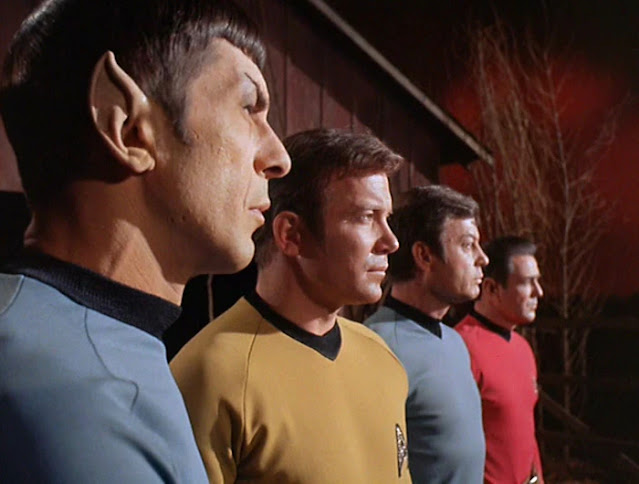‘STAR TREK’ SERIES 3.
Popular opinion has it that the third season of the original series of Star Trek (1966-69) was the death knell for Captain Kirk, Mr Spock, ‘Bones’ McCoy, Scotty and co. The responsibility for this is mainly laid at the door of the show’s new producer, Fred Freiberger. The main symptoms of this change in the show’s production team appear to be a dramatic increase in James T. Kirk’s libido, together with increasingly fetishistic costumes for his female conquests. (Well, it was the late ‘60s).
Apart from that, this particular popular opinion is misleading and rather mystifying.
In particular, Spock and McCoy remain an outstanding double act, fractious and funny – ‘The Tholian Web’ in Series Three is one of their seminal outings. Enjoyable sparks always fly between the fabulous DeForrest Kelley and Leonard Nimoy, and it’s easy to see why the latter was nominated twice for an Emmy award for best supporting actor (in 1966 and 1969). To a modern audience, Spock’s logic and McCoy’s emotionalism may be an obvious contrast, but because of the quality of the actors’ performances, you don’t mind this convenient dramatic seesaw.
I have vivid memories of Star Trek from growing up in the 1970s, when the show seemed to always be on during the week and every rainy school holiday. Turns out most of the episodes I remember the best are all in Season Three: the mesmerising, surreal ‘Spectre of the Gun’ (above); ‘For the World is Hollow and I Have Touched the Sky’, which puts McCoy centre stage in a touching romance; the aforementioned ‘Tholian Web’; ‘Is There in Truth No Beauty?’, in which the physical appearance of an alien ambassador causes insanity, a great idea; the disturbing ‘Plato’s Stepchildren’, banned from UK terrestrial TV for many years… and they stand up very well today.
Maybe Series Three has such a bad reputation because it started with the clunkily titled ‘Spock’s Brain’. In this bizarre, bad comic strip, the Vulcan’s brain is removed to power a world run by young women in mini dresses and thigh boots. When a series opens with a first night like that, it’s going to be an uphill struggle to recover the trust of the audience. However, the more likely explanation for Star Trek’s cancellation was that it was moved from its 8.30 Friday night slot on NBC in America to 10pm, losing its mostly young audience. The ratings tumbled and that was it.
Mind you, Series Three features some quality overacting by William Shatner, which may have made network chiefs a bit nervous. “I’LL KILL YOU!” he rants theatrically at Spock in ‘The Enterprise Incident’, eyes bulging. His scene as the fake, angry Kirk in ‘Whom Gods Destroy’ are jaw-dropping, and his mind-swap with Dr. Janice Lester (Sandra Smith) in ‘Turnabout Intruder’ (below) – the last episode of Star Trek, coincidentally – is high camp. Perhaps the execs were worried that if they went to a fourth series, they’d have no scenery left.
It's a shame, because when The Shat is restrained, he’s a damn fine actor. One of his finest performances as Kirk is in the first series’ ‘Miri’ - on the back foot on a planet full of murderous children, with no back-up, James T. has to reason his way out, and Shatner is a commanding presence.
So, Star Trek Series
Three: popular opinion is again found wanting.




Comments
Post a Comment